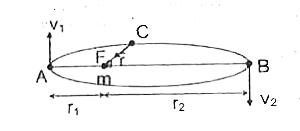Consider a planet moving in an elliptical orbit round the sun. The work done on the planet by the gravitational force of the sun
in some parts of the orbit
in any part of the orbit
in no part of the orbit
in one complete revolution
The correct Answer is:A, D
Step by step video & image solution for Consider a planet moving in an elliptical orbit round the sun. The work done on the planet by the gravitational force of the sun by Physics experts to help you in doubts & scoring excellent marks in Class 12 exams.
Updated on:21/07/2023Topper's Solved these Questions
Similar Questions
Knowledge Check
A planet revolves in elliptical orbit around the sun. (see figure). The linear speed of the planet will be maximum at
 AABBCCDD
AABBCCDDA planet is revolving in an elliptical orbit around the sun. Its closest distance from the sun is r and the farthest distance is R. If the velocity of the planet nearest to the sun be v and that farthest away from the sun be V. then v/V is
AR2/r2Br2/R2CR/rDr/R
Statement-1:When a planet approches the point which is farthest from the sun, its orbital speed decreases.
Statement-2: Work done on the planet by the gravitational force exerted by the sun is negative.
View SolutionFigure shows a planet in an elliptical orbit around the Sun S. Where is the kinetic energy of the planet maximum?

View SolutionIn the figure shown a planet moves in an elliptical orbit around the sun. Compare the speeds, linear and angular momenta at the points A and B.

View SolutionSTATEMENT -1 : When a planet revolves around Sun in an elliptical orbit, the work done Sun's gravitational force on the planet remains zero for any value of displacement.
and
STATEMENT -2 : The mechanical energy of Sun planet system remains conserved throughout the motion of planet.
View SolutionA planet revolves in elliptical orbit around the sun. (see figure). The linear speed of the planet will be maximum at

View SolutionA planet is revolving in an elliptical orbit around the sun as shown in the figure. The areal velocity (area swapped by the radius vector with respect to sun in unit time) is:

View Solution
